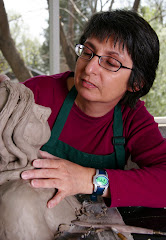So much goes on behind the scenes.
Since I spend a lot of time sculpting a piece, I want complete control over the colors--no "glaze surprises" (there is no such thing--too many variables--application, kiln atmosphere, but we can always hope!). As a fellow clay artist said, "When you open the kiln, it's either Christmas... or Halloween."
Now, I am trying to be more spontaneous, and do like surprises. Even get some "happy surprises" when I open the kiln. But sometimes it's Halloween. Happens to everyone in this business.
I also want consistency.
The answer is to use commercial underglazes, after testing them on small slabs of clay--test tiles. Since clay is made of a mixture of of products from the earth, there is some variation in the composition of different batches of clay. For example, the latest batches have talc that is very different from that of earlier batches. In fact, the wet clay is a different color and consistency. It still fires up white and so far works well with my glazes and underglazes. But I'll be running lots of test tiles with this new clay.
And, as when you paint a small area on the wall only to discover a color looks different in context or when the whole wall is painted, so it goes with some of the underglazes. For example, people can have very bright blue eyes. BUT, when I used what I thought would be good colors for blue eyes, I got scary looking people with laser beam eyes. Yikes! They just followed you around the room. Same with skin tones--some people looked quite jaundiced.
In future work, I might want these effects, but that hasn't been the case so far.
Also I have found that the color can change slightly if it was applied before the first firing (on greenware) vs. after (bisque) , or refired. (Some of these pieces get fired three or four times.) That's OK for a shirt, but can be disturbing for skin tones, eye colors, and even animal coat colors. So, I have been seeking blues that have a touch of lavender or grey in them. And I keep a lot of records, including when the underglaze was applied and batch number.
After many test tiles to find good colors for skin tones, blue eyes, and cat colors, I ordered more underglazes yesterday. Unfortunately, the choices are limited. Many of the colors I worked with years ago are no longer made--companies are much more safety conscious and now (a good thing!) and some of the chemicals in glazes and underglazes were not safe. And some promising colors that I recently tested, so thought were available, were not in stock. The supplier thinks they may have recently been discontinued
Needless to say, the quest continues...









